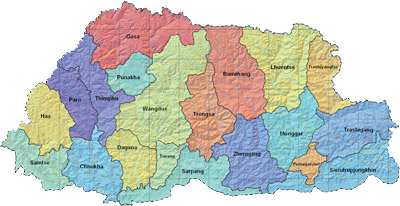Home / About Bhutan
About Bhutan
National Flag
The national flag was created in 1947 by Mayum Choying Wangmo Dorji and modified in 1956 to take its final shape. The Bhutanese flag is divided diagonally and depicts a white dragon across the middle. The upper part of the flag is golden yellow, representing the secular power of the king, while the lower part is orange, symbolising the Buddhist religion. The dragon, whose white colour is associated with purity, represents Bhutan. The jewels held in its claws stand for the wealth and perfection of the country.
Weather/Climate
The central valleys of Punakha, Wangdiphodrang, Mongar, Trashigang and Lhunsthi enjoy a semi tropical climate with very cool winters, while Thimphu, Paro, Tongsa and Bumthang have pleasant summer, cold winters, with monsoon rains mainly from June-August.
At the end of September, after the last of the big rains, autumn suddenly arrives, and is a magnificent season for trekking until November.
Winter in Bhutan starts from the end of November until Febuary, and at this time of the year the climate is dry, with daytime temperatures sometimes falling below zero Celsius.
The southern part of Bhutan is tropical, and in general the east of Bhutan is warmer than the west of the country.
Time
Bhutan time is 6 hours ahead of GMT and there is only one time zone throughout the country.
Language
The national language is Dzongkha. English is widely spoken in major towns and is a medium of education in schools. Other widely spoken languages are Nepali, Bumthap, Sharchop and Hindi. There are a host of local dialects spoken in small pockets within the country.
Facts and figures
| Full Country Name | Kingdom of Bhutan |
| Government | Constitutional Monarchy |
| King | Jigme Khesar Namgyal Wangchuck |
| Prime Minister | Gets elected from the ruling party |
| Capital City | Thimpu (Population: 80,000) |
| Population | 700,000 (approax. 1 million) |
| Area | 38,ooo sq km |
| Religion | 70% Buddhist, 25% Hindu, 5% others |

Map of Bhutan
© Copyright 2024. Bhutan Tours and Treks. All Rights Reserved.